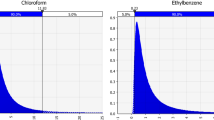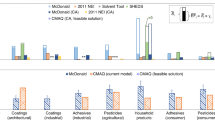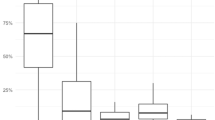Abstract
Many people spend time in stores and restaurants, yet there has been little investigation of the influence of these microenvironments on personal exposure. Relative to the outdoors, transportation, and the home, these microenvironments have high concentrations of several volatile organic compounds (VOCs). We developed a stochastic model to examine the effect of VOC concentrations in these microenvironments on total personal exposure for (1) non-smoking adults working in offices who spend time in stores and restaurants or bars and (2) non-smoking adults who work in these establishments. We also compared the effect of working in a smoking versus non-smoking restaurant or bar. Input concentrations for each microenvironment were developed from the literature whereas time activity inputs were taken from the National Human Activity Patterns Survey. Time-averaged exposures were simulated for 5000 individuals over a weeklong period for each analysis. Mean contributions to personal exposure from non-working time spent in stores and restaurants or bars range from <5% to 20%, depending on the VOC and time-activity patterns. At the 95th percentile of the distribution of the proportion of personal exposure attributable to time spent in stores and restaurants or bars, these microenvironments can be responsible for over half of a person's total exposure to certain VOCs. People working in restaurants or bars where smoking is allowed had the highest fraction of exposure attributable to their workplace. At the median, people who worked in stores or restaurants tended to have 20–60% of their total exposures from time spent at work. These results indicate that stores and restaurants can be large contributors to personal exposure to VOCs for both workers in those establishments and for a subset of people who visit these places, and that incorporation of these non-residential microenvironments can improve models of personal exposure distributions.
This is a preview of subscription content, access via your institution
Access options
Subscribe to this journal
Receive 6 print issues and online access
$259.00 per year
only $43.17 per issue
Buy this article
- Purchase on Springer Link
- Instant access to full article PDF
Prices may be subject to local taxes which are calculated during checkout




Similar content being viewed by others
References
Adgate J.L., Church T.R., Ryan A.D., Ramachandran G., Fredrickson A.L., Stock T.H., Morandi M.T., and Sexton K. Outdoor, indoor, and personal exposure to VOCs in children. Environ Health Perspect 2004a: 112(14): 1386–1392.
Adgate J.L., Eberly L.E., Stroebel C., Pellizzari E.D., and Sexton K. Personal, indoor, and outdoor VOC exposures in a probability sample of children. J Expo Anal Environ Epidemiol 2004b: 14: S4–S13.
Batterman S.A., Peng C.-Y., and Braun J. Levels and composition of volatile organic compounds on commuting routes in Detroit, Michigan. Atmos Environ 2002: 36: 6015–6030.
Burke J.M., Zufall M.J., and Ozkaynak H. A population exposure model for particulate matter: case study results for PM2.5 in Philadelphia, PA. J Expo Anal Environ Epidemiol 2001: V11 (N6): 470–489.
Clayton C.A., Pellizzari E.D., Whitmore R.W., Perritt R.L., and Quackenboss J.J. National Human Exposure Assessment Survey (NHEXAS): distributions and associations of lead, arsenic and volatile organic compounds in EPA Region 5. J Expo Anal Environ Epidemiol 1999: 9: 381–392.
Cullen A.C., and Frey H.C. Probabilistic Techniques in Exposure Assessment. Plenum Press, New York, 1999.
Environmental Health and Engineering. A Screening-Level Ranking of Organic Chemicals and Metals Found in Indoor Air. Environmental Health and Engineering Inc., Newton, MA, 2002.
Fruin S.A., Denis M.J.S., Winer A.M., Colome S.D., and Lurmann F.W. Reductions in human benzene exposure in the California South Coast Air Basin. Atmos Environ 2001: 35 (6): 1069–1077.
Georgopoulos P.G., Wang S.-W., Vyas V.M., Sun Q., Burke J., and Vedantham R., et al. A source-to-dose assessment of population exposures to fine PM and ozone in Philadelphia, PA, during a summer 1999 episode. J Expo Anal Environ Epidemiol 2005: 15 (5): 439–457.
Girman J., Hadwen G., Burton L., Womble S., and McCarthy J.F. Individual Volatile Organic Compound Prevalence and Concentrations in 56 Buildings of the Building Assessment Survey and Evaluation (BASE) Study. Proceedings of Indoor Air 1999 1999: 2: 460–465.
Gordon S., Callahan P., Nishioka M., Brinkman M., O'Rourke M., Lebowitz M., and Moschandreas D. Residential environmental measures in the National Human Exposure Assessment Survey (NHEXAS) pilot study in Arizona: preliminary results for pesticides and VOCs. J Expo Anal Environ Epidemiol 1999: 9: 456–470.
Graham S.E., and McCurdy T. Developing meaningful cohorts for human exposure models. J Expo Anal Environ Epidemiol 2004: 14 (1): 23–43.
Hanninen O., Kruize H., Lebret E., and Jantunen M. EXPOLIS simulation model: PM2.5 application and comparison with measurements in Helsinki. J Expo Anal Environ Epidemiol 2003: 13 (1): 74–85.
Kim Y.M., Harrad S., and Harrison R.M. Concentrations and sources of VOCs in domestic and public microenvironments. Environ Sci Tech 2001: 35: 997–1004.
Kleipeis N.E., Nelson W.C., Ott W.R., Robinson J.P., Tsang A.M., and Switzer P., et al. The National Human Activity Pattern Survey (NHAPS): a resource for assessing exposure to environmental pollutants. J Expo Anal Environ Epidemiol 2001: 11 (3): 231–252.
Kruize H., Hanninen O., Breugelmans O., Lebret E., and Jantunen M. Description and demonstration of the EXPOLIS simulation model: two examples of modeling population exposure to particulate matter. J Expo Anal Environ Epidemiol 2003: 13 (2): 87–99.
Lee S.-C., Guo H., Li W.-M., and Chan L.-Y. Inter-comparison of air pollutant concentrations in different indoor environments in Hong Kong. Atmos Environ 2002: 36: 1929–1940.
Loh M.M., Houseman E.A., Gray G.M., Levy J.I., Spengler J.D., and Bennett D.H. Measured concentrations of VOCs in several non-residential microenvironments in the United States. Environ Sci Technol 2006: 40 (22): 6903–6911.
Loh M.M., Levy J.I., Spengler J.D., Houseman E.A., and Bennett D.H. Ranking cancer risks of organic hazardous air pollutants in the United States. Environ Health Perspect 2007: 115 (8): 1160–1168.
McCurdy T., and Graham S.E. Using human activity data in exposure models: analysis of discriminating factors. J Expo Anal Environ Epidemiol 2003: 13 (4): 294–317.
McCurdy T., Glen G., Smith L., and Lakkadi Y. The National Exposure Research Laboratory's consolidated human activity database. J Expo Anal Environ Epidemiol 2000: 10: 566–578 (www.epa.gov/chadnet1/, accessed May 27, 2003).
Oracle, Crystal Ball, Oracle 2008.
Ott W.R. A physical explanation of the lognormality of pollutant concentrations. J Air Waste Manage Assoc 1990: 40 (10): 1378–1383.
Ozkaynak H., Palma T., Touma J.S., and Thurman J. Modeling population exposures to outdoor sources of hazardous air pollutants. J Expo Sci Environ Epidemiol 2007: 18 (1): 45–58.
Payne-Sturges D.C., Burke T.A., Breysse P., Diener-West M., and Buckley T.J. Personal exposure meets risk assessment: a comparison of measured and modeled exposures and risks in an urban community. Environ Health Perspect 2004: 112 (5): 589–598.
Reiss R., Ryan P.B., Tibbetts S.J., and Koutrakis P. Measurement of Organic Acids, Aldehydes, and Ketones in Residential Environments and their Relation to Ozone. J Air and Waste Manage. Assoc., 1995: 45: 811–822.
Rodes C., Sheldon L., Whitaker D.A., Clayton A., Fitzgerald K., and Flanagan J., et al. Measuring Concentrations of Selected Air Pollutants Inside California Vehicles. Final report ARB contract no. 95–339, California Air Resources Board, Sacramento, CA, South Coast Air Management District 1998, Diamond Bar, CA.
Saarela K., Tirkkonen T., Laine-Ylijoki J., Jurvelin J., Nieuwenhuijsen M.J., and Jantunen M. Exposure of population and microenvironmental distributions of volatile organic compound concentrations in the EXPOLIS study. Atmos Environ 2003: 37 (39-40): 5563–5575.
Sax S.N., Bennett D.H., Chillrud S.N., Kinney P.L., and Spengler J.D. Differences in source emission rates of volatile organic compounds in inner-city residences of New York City and Los Angeles. J Expo Anal Environ Epidemiol 2004: 14 (Suppl 1): S95–S109.
Sexton K., Adgate J.L., Ramachandran G., Pratt G.C., Mongin S.J., and Stock T.H., et al. Comparison of personal, indoor, and outdoor exposures to hazardous air pollutants in three urban communities. Environ Sci Technol 2004: 38 (2): 423–430.
Tsang A.M., and Kleipeis N.E. Descriptive Statistics Tables from a Detailed Analysis of the National Human Activity Pattern Survey (NHAPS) Data. Environmental Protection Agency, 1996. National Exposure Research Laboratory, Office of Research and Development, Las Vegas, NV.
Wallace L.A., Nelson W.C., and Ziegenfus R. The Los Angeles TEAM study: personal exposures, indoor-outdoor air concentrations, and breath concentrations of 25 volatile organic compounds. J Expo Anal Environ Epidemiol 1991: 1 (2): 157–192.
Van Winkle M.R., and Scheff P.A. Volatile organic compounds, polycyclic aromatic hydrocarbons and elements in the air of ten urban homes. Indoor Air-International Journal of Indoor Air Quality and Climate 2001: 11 (1): 49–64.
Weisel C.P., Zhang J., Turpin B.J., Morandi M.T., Colome S., Stock T.H. and, Spektor D.M. Relationships of Indoor, Outdoor and Personal Air (RIOPA): Part I. Data Collection and Descriptive Analyses. HEI Research Report 130; NUATRC Research Report 7. Heath Effects Institute, Boston MA, and Mickey Leland National Urban Air Toxics Research Center, Houston TX, November 2005.
Xue J., McCurdy T., Spengler J.D., and Ozkaynak H. Understanding variability in time spent in selected locations for 7–12 year old children. J Expo Anal Environ Epidemiol 2004: 14: 222–233.
Zhang J., He Q., and Lioy P.J. Characteristics of aldehydes: Concentrations, sources, and exposures for indoor and outdoor residential microenvironments. Environ Sci Technol 1994: 28(1): 146–152.
Acknowledgements
This work was supported by the American Chemistry Council and the International Society for Exposure Analysis Young Investigator Award to Deborah H Bennett.
Author information
Authors and Affiliations
Corresponding author
Appendix
Appendix
Rights and permissions
About this article
Cite this article
Loh, M., Houseman, E., Levy, J. et al. Contribution to volatile organic compound exposures from time spent in stores and restaurants and bars. J Expo Sci Environ Epidemiol 19, 660–673 (2009). https://doi.org/10.1038/jes.2008.62
Received:
Accepted:
Published:
Issue Date:
DOI: https://doi.org/10.1038/jes.2008.62
Keywords
This article is cited by
-
Statistical properties of longitudinal time-activity data for use in human exposure modeling
Journal of Exposure Science & Environmental Epidemiology (2013)



